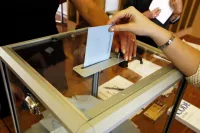Radio technology utilizes radio waves, electromagnetic waves ranging from 3 Hz to 300 GHz, for communication. Transmitters generate these waves via antennas, while receivers with antennas capture them. Beyond communication, radio serves purposes like radar, navigation, remote control, and remote sensing, showcasing its versatile applications.
December 1901: First Transatlantic Signal
In December 1901, Guglielmo Marconi achieved a significant milestone by sending the first transatlantic radio signal.
December 1901: Marconi Transmits Across the Atlantic Ocean
In December 1901, Guglielmo Marconi successfully transmitted radio signals across the Atlantic Ocean.
December 1904: Use of the word 'Radio'
On December 30, 1904, the British Post Office specified that "The word 'Radio'... is sent in the Service Instructions."
1906: 1906 Berlin Convention
Although its translation of the 1906 Berlin Convention used the terms wireless telegraph and wireless telegram, by 1912 it began to promote the use of radio instead.
1906: International Adoption of 'Radio'
In 1906, the Berlin Radiotelegraphic Convention included a Service Regulation specifying that "Radiotelegrams shall show in the preamble that the service is 'Radio'", introducing the word "radio" internationally.
June 1907: De Forest Radio Telephone Company Founded
In early 1907, Lee de Forest founded the DeForest Radio Telephone Company. On June 22, 1907, he warned about "Radio chaos" without stringent regulation in Electrical World.
1908: Global Radiotelegraphy Networks Established
Starting around 1908, industrial countries built worldwide networks of powerful transoceanic transmitters to exchange telegram traffic between continents and communicate with their colonies and naval fleets.
1909: Nobel Prize for Marconi and Braun
In 1909, Marconi and Karl Ferdinand Braun shared the Nobel Prize in Physics for their contributions to the development of wireless telegraphy.
1910: Need for Precise Terminology
Around 1910, the term 'wireless telegraphy' was used for different experimental systems. A need for a precise term exclusively referring to electromagnetic radiation arose.
1912: US Navy promotes use of Radio
By 1912, the United States Navy began to promote the use of radio instead of wireless telegraphy.
November 1920: First Commercial Radio Broadcast
On November 2, 1920, Westinghouse Electric and Manufacturing Company broadcast the Harding-Cox presidential election results under the call sign KDKA in Pittsburgh, marking the first commercial radio broadcast.
1920: Beginning of AM Broadcasting
Around 1920, AM broadcasting began, marking the early stages of analog audio radio broadcasts.
2006: Introduction of HDTV Standard
Beginning in 2006, the current television standard, a digital format called high-definition television (HDTV), was introduced, transmitting pictures at a higher resolution.
Mentioned in this timeline
The United States of America is a federal republic located...

Pittsburgh is a city in southwestern Pennsylvania situated at the...

An election is a structured decision-making process where a population...
The Atlantic is a magazine and multi-platform publisher headquartered in...

Telegraphy involves transmitting messages over long distances using codes understood...
A presidential election is a formal process through which a...
Trending

11 days ago Dick Vitale and Charles Barkley Team Up for College Basketball Broadcasts This Season

1 month ago Kim Kardashian's 'All's Fair' TV show faces criticism despite Niecy Nash's defense.
10 days ago Marcus Freeman: Notre Dame coach considered for Giants head coaching vacancy in NFL.
Jeremiyah Love is an American college football running back He currently plays for the Notre Dame Fighting Irish He is...

7 months ago Trump's Tariffs Threaten Cannes 2025, SAG-AFTRA Responds, Impacting Spike Lee's Industry.

7 months ago Mitchell Robinson's Playoff Impact: Knicks' Gamble Pays Off as Hart Shines in Game 3
Popular

Candace Owens is an American conservative political commentator and author...

Ilhan Omar is an American politician currently serving as the...

XXXTentacion born Jahseh Dwayne Ricardo Onfroy was a controversial yet...

Tom Cotton is an American politician and Army veteran currently...
The Kennedy Center Honors are annual awards recognizing individuals and...
Matt and Ross Duffer known as the Duffer Brothers are...